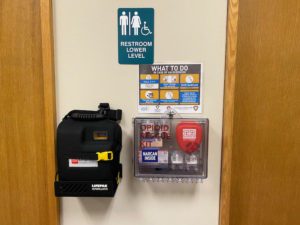Who is a member?
Our members are the local governments of Massachusetts and their elected and appointed leadership.

NaloxBoxes installed around the city can help members of the public reverse opioid overdoses and save lives.
In an effort to prevent more opioid-related deaths, Easthampton has installed more boxes around the city to provide free public access to the overdose-reversing drug naloxone.
In May, Easthampton had installed “NaloxBoxes” in several municipal and school buildings, so that members of the public could administer nasal naloxone doses to people who were overdosing, or take doses for future use. By late August, the city had also installed boxes in several businesses, to expand public access to the life-saving drug, which is also known by the brand name Narcan. Easthampton now has nine boxes in the community.
“Opioid abuse affects everyone,” said Mayor Nicole LaChapelle. “No one is immune in Easthampton. The box placements give easy access to those in need, and put the general public on notice that they too can save a life.”
Like other communities nationwide, the city has faced the problem of opioid-related overdoses for years. According to the Easthampton Police Department, the city had 89 overdoses between 2018 and March 2022, 14 of which were fatal. Between 2020 and 2021, 22 overdoses occurred in public locations, officials said.
Easthampton had wanted to install the NaloxBoxes for a while, said Bri Dupras, the city’s public health director. Neighboring Northampton had installed boxes in 2019, she said, but the pandemic delayed Easthampton’s effort. The city received the boxes for free from Hampshire HOPE, a regional coalition that is based out of the Northampton Health and Human Services Department to help local communities address the opioid crisis.
During the first phase, in early May, Easthampton placed the boxes in City Hall, the public library, the middle school and the high school. Labeled “Opioid Rescue Kit,” each wall-mounted NaloxBox contains four medicine doses, a rescue breathing mask, medical gloves, instructions and information about local resources.
“There’s no lock on it, you don’t have to break the glass, there’s no alarm that goes off,” Dupras said. “You can help yourself to the Narcan in there. And we hope people do.”
Easthampton held trainings for the public and for city staff, and posted a video on the Health Department’s website. In particular, Dupras said, officials wanted to emphasize that naloxone won’t hurt people who aren’t overdosing and who receive it inadvertently.
Officials had long wanted to expand the program to businesses, Dupras said, but waited to see how the public-building boxes fared first. Her department met with police and fire leaders, and with City Councillor Owen Zaret, to identify private-business locations, she said. In choosing candidates, the group considered overdose data, geographic factors, building foot traffic and businesses with nighttime hours, she said.
In the end, officials arranged for boxes in five new locations, including a sports bar, a food cooperative, a brewery, a reception venue, and Learn to Cope, an addiction and recovery support network. Except for a chain store that declined to participate, she said, businesses were eager to host the boxes. Demonstrating the program first in the public buildings made the pitch to businesses easier, she said.
“I’m glad we did it this way, because I think the community and business owners were made aware of the program and got comfortable with it before we just came to them out of the blue and said, ‘Hey, do you want to host a NaloxBox?’” Dupras said.
The private businesses are responsible for monitoring the boxes and requesting refills. Since the program began in May, Dupras said that she is aware of three doses having been taken from the boxes.